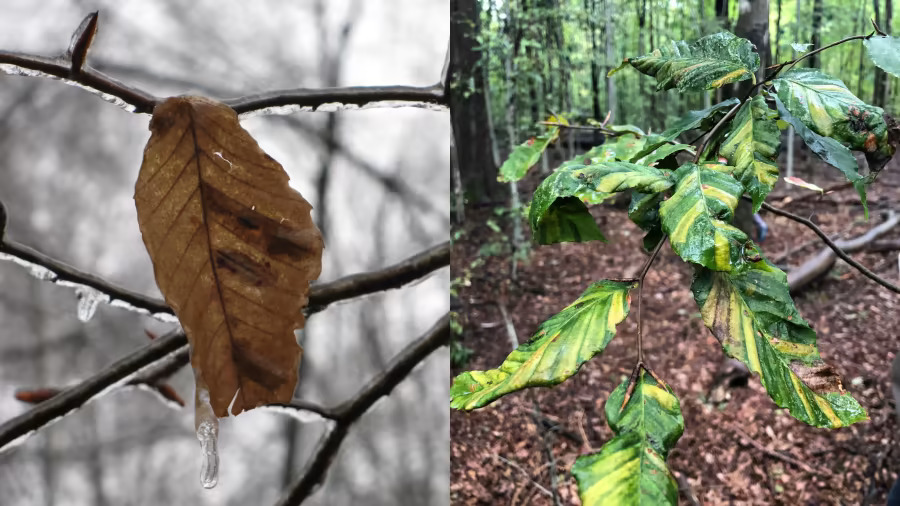Michigan recently found the first signs of invasive beech leaf disease in four counties this past July, discovering that the species can die within 6-10 years if not treated. Since then, authorities have investigated ways to protect and prevent its magnanimous spread in Michigan’s 37 million American beech trees. Simeon Wright, a forest health specialist from the Department of Natural Resources, encourages residents to check their beech trees for signs of the dangerous pestilence before it is too late. The beech tree remains vulnerable to both beech leaf disease and beech bark disease, causing a potentially “devastating” effect. Yet, people remain unsure of a working treatment to stop its spread.
The Spread of Beech Leaf Disease in Michigan
Michigan is proud to be the first state to confirm invasive beech leaf disease in July 2022. Since then, it has been detected in Lenawee, Oakland, Washtenaw, and Wayne counties. This disease is caused by the microscopic worm Litylenchus crenatae and weakens trees so much that they can die within six to 10 years after initial symptoms. To protect its 37 million American beech trees, Michigan residents are encouraged to check their trees for signs of beech leaf disease, which spread in January 2023. These trees provide food and shelter for wildlife, making them an essential part of Michigan’s natural environment.
Signs of Beech Leaf Disease

Simeon Wright, Michigan Department of Natural Resources forest health specialist, encourages individuals to take time now to check their beech trees for signs of disease. In 2022, Wright expressed that the disease can be identified by dark, thick bands between leaf veins, which can be seen on green and brown leaves. With fall now upon us, Wright is confident that it is not too late to detect any possible signs of the beech leaf disease.
Potential Devastation of Beech Leaf Disease in Michigan
It is impressive that, despite the beech leaf disease’s detection in Ohio in 2012 and its spread to other states and Ontario, there remains no known treatment for this pestilence. The potential of it spreading to Michigan could have a “devastating” effect on the beech trees. Yet, the disease may have come from the movement of infested nursery stock and other beech material containing leaves and buds. Beech trees are also under attack from beech bark disease, making these trees especially vulnerable. However, it is encouraging that it has been identified and steps can be taken to prevent further spread.
Early signs of beech leaf disease can include dark, thickened stripes between leaf veins, aborted leaf buds, and curling, and the Michigan Department of Natural Resources is encouraging citizens to watch for these symptoms.
Identification of Nematode Infestation
Tree experts have noted that nematodes can be identified by inspecting the leaves for damaged tissue, dead buds, and darkened, thick bands between leaf veins. This creates a striped effect on the foliage, especially when viewing the trees from below on a sunny day. The leaves curl and distort as infestation intensifies, eventually turning yellow or withered with a severely thinned canopy. By early summer, the effects of the infestation are very noticeable in heavily affected trees.
Understanding Beech Leaf Disease
State agencies are actively working with the U.S. Forest Service, several other states, Ontario, and Michigan State University to understand better beech leaf disease and its potential impacts on Michigan’s forests. Although much is still unknown about the disease, officials are confident that further research will help answer many of the questions surrounding it, and they remain hopeful that treatments will be developed to protect trees and reduce disease impacts.
Reporting Beech Leaf Disease
Kayla Clarke is a highly skilled Web Producer for ClickOnDetroit. She worked with WILX in Lansing as a digital producer before joining the team in 2018. Kayla is proud to share her knowledge on beech leaf disease and other watch list species, encouraging individuals to take action if they believe they have found a symptomatic tree. Photos should be taken of the leaves, including close-ups, and the location, date, and time should all be noted before reporting the tree through one of the provided options. Regular tree maintenance or the help of a certified arborist can also assist with managing diseases that could easily be mistaken for beech leaf disease.
Michigan’s 37 million beech trees are in danger from the devastatingly destructive beech leaf disease. Unfortunately, there is currently no known treatment to eradicate this pestilence, so it is essential that individuals now check their beech trees for signs of beech leaf disease symptoms: dark, thick bands between leaf veins. It is encouraging to note that authorities have identified and acted quickly to prevent the spread from Ohio into Michigan to help protect these invaluable fault lines in nature’s natural environment.
[button link=”https://www.clickondetroit.com/news/michigan/2023/10/28/theres-still-time-to-check-michigan-trees-for-beech-leaf-disease/” newwindow=”yes”]Learn More[/button]
